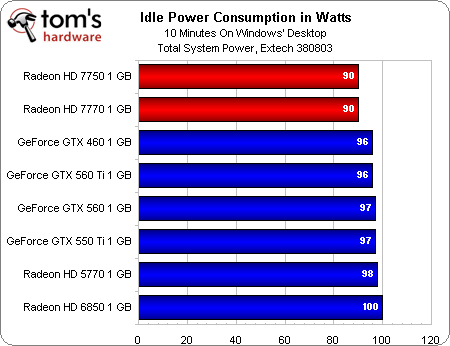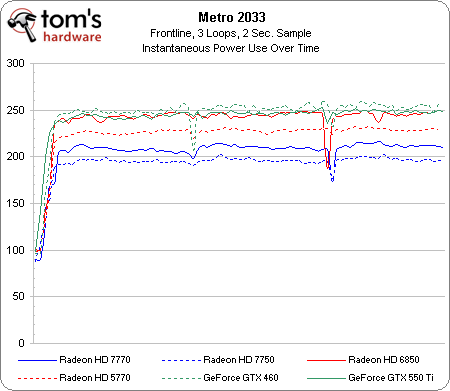AMD Radeon HD 7770 And 7750 Review: Familiar Speed, Less Power
These are the lowest-end cards built using AMD's new Graphics Core Next architecture. Is 28 nm manufacturing, a fresh design, and new functionality enough to warrant upgrading existing value-oriented champs like the Radeon HD 6850 and GeForce GTX 460?
Power Consumption
Alright, so, I’d argue that neither the Radeon HD 7770 nor the 7750 push mainstream graphics performance up at their price points. You can already buy a 256-bit GeForce GTX 460 or Radeon HD 6850 for what AMD plans to sell the 7770 for, and both of those boards are, on average, faster.
These cards do have a profound impact on power, though. That much is obvious from their TDPs, dimensions, and auxiliary connectors.
At idle, sitting on the Windows 7 desktop, our overclocked Core i7-3960X-based machine shows both Radeon HD 7700-series chips cutting system consumption by 6 W compared to the GeForce GTX 460 and 560 Ti. AMD’s older Radeon HD 6850 uses 10 W more.
And then you’re able to factor in ZeroCore, a collection of power-saving technologies that kick in as soon as our test platform’s display switches off. Cooling fans stop spinning, clock rate drops, and on-board memory goes to sleep. The result is a further 6 W shave down to 84 W total system power on both 7700s.
The competing cards, on the other hand, don’t manage to cut consumption by much at all (1 W in a handful of cases).
The above graph is what this story is all about. AMD isn’t hitting particularly amazing price points, it’s not doing anything amazing for performance, but it is doing everything that the previous generation of cards from both companies could do at significantly lower power. As a result, efficiency improves and you get a lot more performance per watt consumed.
Get Tom's Hardware's best news and in-depth reviews, straight to your inbox.
Current page: Power Consumption
Prev Page Benchmark Results: MediaEspresso And Luxmark 2.0 Next Page Temperature And Noise-
Derbixrace the 7750 will be a GREAT card compared to the 6670 for those who have a shitty 300w PSU and wants a nice GPU.Reply -
phamhlam If the 7770 is the same price as the 6850. I think we have the best value card right here. The 6850 was a great budget card but this card will change that.Reply -
dragonsqrrl "Although other cards beat it in encryption and decryption performance, the Radeon HD 7750 easily secures a second-place finish in the SHA256 hashing test."Reply
I think you mean AES256. -
jprahman The fight shaping up between all these new AMD cards and Kepler is looking to be a good one. Time to just sit back with some popcorn and enjoy the show... while planning a new build for when the price war breaks out.Reply -
esrever Seems ok, New stuff ussually cost more. The 6770 being more expensive than the 5770, the 6870 being more expensive than the 5850 ect.Reply
I'd expect prices to go down once supply goes up and demand goes down. -
confish21 What a sad release. I'm not even excited for Pitcairn now! I foresee the $170 6870 to hold its own.Reply -
This is ridiculous. Man this sucks, i've been waiting for the 7770 since early last year, and this crap is what they release?Reply
What_were_they_thinking? -
wicketr Well....here's hoping for a good 7850/7870 release on March 6th. Not much here worth spending money on IMO.Reply -
buzznut This is unfortunate, considering the naming scheme. The 4770, 5770, and 6770 were/are all good budget cards that performed above where they were priced. Bang for buck has always been the draw here, but that 7770 is overpriced. Hopefully AMD will see this fumble; I agree at $120-130 this card makes a lot more sense.Reply
I'd actually like to see the HD 7750 at a lower price too, as we know these prices will drop over time but I still think this is slightly high for launch.



